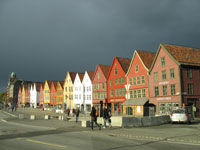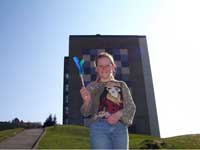Curiosity killed the cat – or did it? Inspire article
Frode Skjold tells Sai Pathmanathan about some of his favourite activities to teach science in primary school.

Image courtesy of Frode Skjold
Frode Skjold has been teaching in Norway since 1994, and is currently working at Ulsmåg primary school in Bergen. The country’s second largest city, this seaport in the west of Norway is renowned for its pouring rain, colourful wooden houses and good fish.
Frode describes himself as a jack of all trades – teaching all core subjects in primary school (focusing on basic skills such as mathematics, reading and writing) – but his passion is for science and he has never yet met a child who isn’t interested in it too.
Frode grew up on a little farm near the sea with four brothers. His parents, who were both teachers, were very enthusiastic and often spoke to their boys about nature and science. It didn’t take long for Frode and his brothers to start exploring the local flora and fauna. As children, they went on long hikes, recording the kinds of birds they saw, as well as fishing, playing in the woods and tending the farm animals. The foundation for a lifelong interest was laid without them even realising. Three of his brothers are now working in scientific fields – one is a landscape architect, while the others work in environmental management and fisheries science – and Frode is proud to be a science teacher.
His educational background is eclectic, made up of a little of everything, as he has to teach all subjects – from Norwegian to science. He specialised in biology and physics, but he doesn’t count formal education as his only education. “What I learn through teaching and from the daily contact with pupils is such an educational experience for me,” says Frode. “Most kids are natural researchers with their own curiosity and the need to experiment, classify and verify. The pupils’ thirst for knowledge constantly challenges us teachers to find new approaches to our teaching.”

Image courtesy of Perplex;
image source: Wikimedia Commons
He’s a naturally curious person and thinks that being curious in the company of children is as good an education as anything else. He believes that if pupils are presented with the right scientific context and the tools, that is enough. Pupils can work out the experiments all by themselves; instead of showing them the way, the teachers can inspire the pupils to discover the path themselves.
Frode works with the Research Council in Norway on their project for primary school children, Nysgjerrigperw1 (in English, ‘curious Peter’ – the Norwegian name for someone who wants to know about and questions everything). He is one of their ‘resource teachers’, sharing his experience, knowledge and teaching activities with other science teachers across Norway, and giving short lectures on using scientific working methods in the primary-school science classroom, the ‘Nysgjerrigper method’w2.
For the Nysgjerrigper research competition each year, Frode starts with a research project for his class, challenging the pupils to explain ‘inexplicable’ phenomena; they have competed very successfully for the past six years. As we all know, teaching is full of highs and lows, but Frode is fascinated by the success stories he has witnessed. One particular experience comes to mind.
“My class had decided to embark upon a new research project: how to make a piece of wood fly up in the air, at least 30 metres high,” Frode recalls. “The pupils had so many suggestions as to how this could be done. They carved their pieces of wood, sanded and rounded down the points in order to reduce the air resistance. A physicist from one of the universities told us that the piece of wood should have an initial speed of 90 km/h. But the pupils knew that we could never gain such a speed using only our hands and arms; we needed some sort of device to fling the piece of wood into the air. After discussing this, we settled on using a long stick as an extension of our arms, and attaching a rope to this stick. If we only could find a way to transmit the power from the rope to the piece of wood, it would now gain a tremendous speed – or at least, so we hoped. Working on this problem, we tried to follow the experts’ instructions about transmission and design down to the last detail.”

Image courtesy of Pål S. Schaathun
; image source: Wikimedia Commons
One of Frode’s pupils, a quiet girl, did not approve of the proposed design. She carved her own piece of wood to look more like a big pencil or arrow, about 20 to 30 centimetres long, and then attached two feathers to the arrow’s rear end. Towards the front end she cut a notch where the rope’s end could fit in and be secured with a knot.
“When we tried it out, the girl’s arrow sped out from the rope and continued to fly further and further up, pointing beautifully upwards all the way,” remembers Frode. “When it finally lost power, it fell down gracefully, pointing downwards, thanks to the feathers. The girl who came up with the arrow design was a quiet and careful one, but obtained what everyone had dreamed of!”
The arrow had flown over 30 metres high, and the goal was thus accomplished. This was a challenge – a scientific challenge that all children excitedly took part in. Frode has yet to meet a child who is not interested in science. He has faith that all children have an inborn curiosity, and an urge to experiment and challenge established facts.
Teachers often feel that their science teaching suffers as a result of poor equipment and facilities. Whilst Frode agrees, he feels that a great number of scientific studies can be carried out using free or very cheap materials, such as cans, old bottles, ropes, water and air. “One teacher at every school could specialise in researching ways to run easy experiments, co-ordinating purchases, inspiring other teachers, demonstrating experiments during lunch hours, developing equipment and so forth,” says Frode. But he realises that he may just be one of the lucky ones. “Our local authority in Bergen gives high priority to school science.” The only thing Frode would wish for is a designated classroom for science so that all the equipment can be set up in one place. He thinks the lack of such a room is the reason why some primary-school teachers are reluctant to include practical activities in their teaching.
Between the 1970s and 1990s, science in the primary-school curriculum was taught as part of a multidisciplinary subject that also included social studies. The balance between social studies and science often depended on the individual teacher. More recently, science has been resurrected as an independent subject in the primary-school curriculum – something that makes Frode very happy.
The latest Norwegian curriculum gives detailed descriptions of what pupils are supposed to know at the end of each year. For the first time in his career, Frode and his colleagues at school have agreed on what their pupils should know by the end of the fifth, sixth and seventh grades. Every teacher is committed to this agreement, and Frode feels that this educational reform will help pupils as well as the teaching professionals, as everyone is now aware of the targets to reach.
So there is a need to have common guidelines for each subject. But Frode believes that although there should be some standardisation, there should also be enough space within the curriculum to allow teachers to follow their own interests and scientific curiosity: “A certain amount of impulsivity and expressiveness is needed in teaching. For this reason, you can’t direct a teacher’s job in each and every detail.” And he feels strongly about the need for hands-on experiments. “An experiment should be carried out so that pupils can see first-hand what is happening and easily express what they are learning. The experiment always comes first. If eight experiments aren’t enough for pupils to get the point, you should perform a ninth!”

Image courtesy of Frode Skjold
At present, Frode is touring Norway with his lecture on the Nysgjerrigper method, explaining how to use scientific methods in the primary-school classroom. “The teachers needs to tune in to the researchers’ frequency,” as Frode calls it. They have to open up their minds and think of themselves as scientists. Ask a question, formulate a hypothesis, think of an experiment to test it, perform the experiment and evaluate the results – all this with the main input coming from the pupils.
Frode and the other Nysgjerrigper resource teachers have seen the benefits of this method: the increase in creative thinking, curiosity and active participation among the pupils indicates that this is an excellent supplement to conventional teaching.
Frode also stresses the need for researchers to excite pupils about the wonders of science. He has asked researchers interested in science education to contact schools, arrange events and invite classes to their departments. “For several years now, the Department of Chemistry at the University of Bergen has invited sixth graders (aged 11-12) to visit, introducing the kids to different topics in chemistry,” says Frode. “For pupils in primary school this is an excellent experience, especially because schools are deprived of expensive equipment, such as liquid nitrogen or fume cupboards. However, there is always a long waiting list for visitors to the Department of Chemistry. So maybe this is something that other departments at local universities could consider as well.”
One of Frode’s other projects is ‘The Research Frequencies’. This is a set of worksheets he developed on topics from the ideal design of paper planes to experiments with Cartesian divers. Their purpose is to get pupils, teachers and trainee teachers to tune into their ‘research frequencies’ and open their minds to their innate curiosity and investigation skills. These positive experiences can be life-changing for pupils: they may make up their minds to pursue a career in science, instead of the more popular social sciences.
Interdisciplinary teaching isn’t always easy, but this doesn’t faze Frode. His work combining science with creative writing and painting is nothing short of fascinating. He loves to include Norwegian when teaching science, and a while back his pupils carried out a research project to find out about how dust forms dust bunnies (balls of dust that typically hide under the bed, behind the cupboard, etc.). The pupils cleaned their bedrooms thoroughly at the start of the project and then didn’t clean them for six weeks. During those six weeks, the pupils observed dust bunnies appearing and marked them with tiny, coloured feathers to keep track of the dust bunnies’ movements around their bedrooms. This research led to some rich Norwegian creative writing, including stories written from the point of view of the dust bunniesw3. All of a sudden, pupils were able to think like dust bunnies, dive into the dust bunnies’ world and try out new forms of literary language to describe their thoughts.
“I generally like to vary the genres and styles in my research projects,” says Frode. “Of course you can’t be very creative with numbers and tables, but you can do exciting things like chemical painting. Start off with a sheet of paper soaked in the pigment from red cabbage, and then get the pupils to paint using acids and bases. The pigment goes green when exposed to bases, and pink when using acids. The results are great pieces of art for display.”
His one piece of advice to science teachers: be curious yourselves and help to foster the same curiosity and inherent need for knowledge in your pupils.
Nysgjerrigper
The Nysgjerrigper Science Knowledge Projectw1 is a special initiative of the Norwegian Research Council targeted at pupils and teachers in primary schools. The main objective is to encourage children and teenagers to maintain and cultivate their own curiosity, fantasy and desire to learn. Children deserve exciting, engaging forms of research dissemination. Nysgjerrigper seeks to heighten interest in research and science among young people – and hopes that more of them will choose a career in research.
The resource teachers network
The resource teachers are a network of teachersw4 with special expertise in the Nysgjerrigper method. They can provide other teachers in their areas with tips and advice on how to implement science projects in primary schools. All of the resource teachers have experience with research-related activities in the classroom and have previously participated in the Nysgjerrigper annual science contest for children and their teachers. The resource teachers mainly offer courses in the Nysgjerrigper method, but they also give lectures and other types of presentations at conferences and teachers’ seminars.
Web References
- w1 – To find out more about the Research Council of Norway’s project for primary school children, Nysgjerrigper, see:
- For more extensive information in Norwegian, see: www.nysgjerrigper.no
- A free tool for participation in the annual science contest is available here: www.nysgjerrigpermetoden.no
- w2 – The teachers manual on the Nysgjerrigper scientific working method in primary schools can be downloaded here: www.nysgjerrigper.no/filer/nys_method-eng-web.pdf
- w3 – For more information about the dust-bunny project, see: www.nysgjerrigper.no/Artikler/why-does-dust-form-dust-balls
- w4 – More information about the resource teachers network is available (in Norwegian) here: www.nysgjerrigper.no/Artikler/2004/juli/nysgjerrigpers-ressurslaerere-inspirerer-og-veileder





